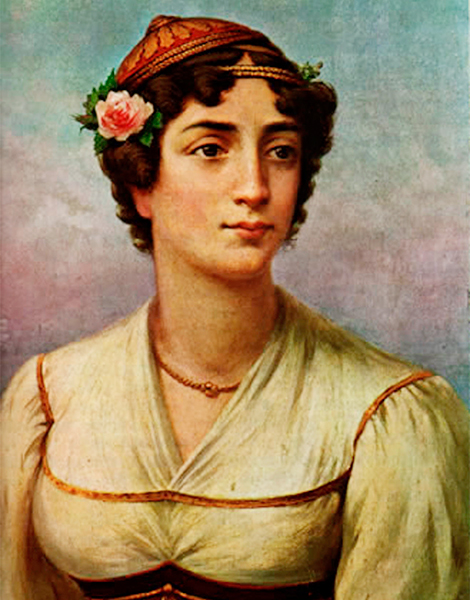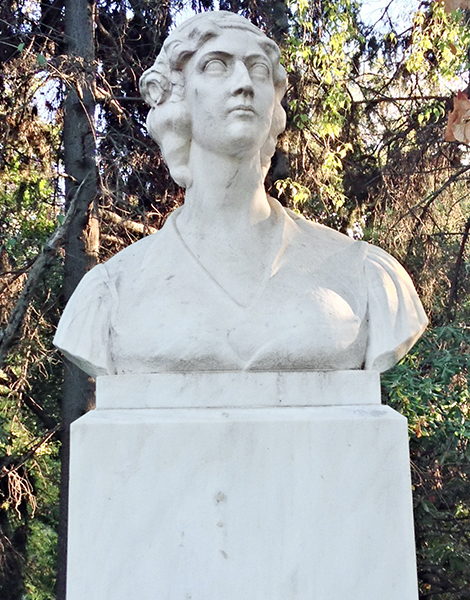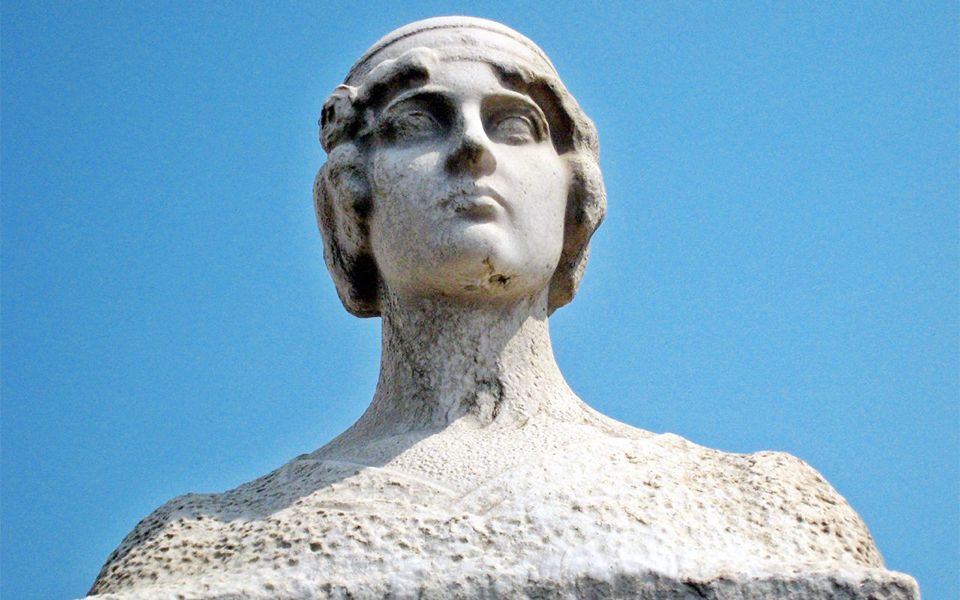Her life story reads like a novel. In battle she was heroic (eventually becoming the only woman to be honored with the title of general-in-chief). She devoted her entire personal fortune to support the struggle for Greek independence, a decision that pitted her against her own family. Her romantic attachment to a prince broke with social conventions, and ultimately ended in betrayal and denial.
Manto Mavrogenous was born in Trieste, Italy, in 1796. She was the fifth child of Nikolaos Mavrogenis, a well-born merchant, and Zacharati Hatzi Bati a Mykonian noblewoman. Many members of her family held high-ranking positions in the Ottoman Empire.
In Trieste, she was known as the “Bella Greca”, the beautiful Greek woman. Mavrogenous had a steady supply of suitors, as her beauty, combined with her exceptional education (she was fluent in French, Italian and Turkish) gained her many admirers.
Independence Fighter
The onset of the Greek revolution in 1821 found her with her mother on the island of Tinos, where they had relocated following her father’s assassination.She immediately crossed to Mykonos, where she incited the locals to revolt against their Ottoman rulers. She used her own funds to arm two ships and continued spending vast sums on the war – some historical sources put the amount at 700,000 groschen, an enormous figure for the time.After pawning her jewellery, she recruited 200 men and led the famous defence of Mykonos against Algerian pirates in October 1822.
Despite contemporary Greek historians remaining largely silent on her contribution during the war for independence, we know that she personally took part in many battles from the writings of European travellers and philhellenes. In Europe, Mavrogenous was already seen by many as the new Joan of Arc, the French heroine. Her open letters to the ladies of French and British society played an important role in bolstering the philhellenic movement. “I yearn for a day of fighting as you yearn for a night of dancing,” she wrote characteristically.
The Prince and Fiance
In early 1823, Mavrogenous relocates to the Peloponnese, at the heart of the insurrection. She pawns part of her dowry, and with the loan she sets herself up in a ruined house in the town of Nafplio. There, she meets Prince Demetrios Ipsilantis, a high-ranking military officer and influential political figure. While they were not matched in appearance – she was a beautiful woman in her mid-20s, while he was a rather plain, short and portly man in his 30s – Mavrogenous falls in love with Ipsilantis.
The two live together for two years, sharing a home in Nafplio. But she also sleeps with him in his tent, scandalising local society and becoming a target for bitter comments such as “the prince is running after the skirts of that western-dressed Mykonos woman.” Their relationship, a romantic love story in the midst of the revolution, is sealed with an engagement and a written promise of marriage from Ipsilantis. But, having spent all of her fortune, life in Nafplio for Mavrogenous is a constant struggle to survive – the life of a fallen aristocrat.
“I yearn for a day of fighting as you yearn for a night of dancing,”

© Visual Hellas

© Nikolaos Kouvaras CC BY 2.0
When the last remaining parts of her dowry were lost in a fire and a robbery, she finds herself homeless and hungry. Fiery as ever, Mavrogenous doggedly pursues her claim for the stolen goods and compensation for damaged property through reports to the authorities.
The Scheming Politician
But these misfortunes were only the beginning. Fearing that a marriage between Ipsilantis and Mavrogenous would unite two great Russophile families, Ioannis Kolettis, a cunning Francophile politician, arranged to have Manto kidnapped and transported to Mykonos by comrades of Ipsilantis, having convinced them that the honor of the army was suffering because of her.
Ipsilantis forgave his comrades but Kolettis did not stop there. He sent Mavrogenous two of Ipsilantis’s personal physicians, who pressed her to part from him for health reasons. The final blow came with a malicious rumour spread by the same scheming politician that Mavrogenous was cheating on the prince with the English philhellene Edward Blanquiere. Stung by this, Ipsilantis rescinded his promise of marriage, and the two lovers never reconciled.
On top of betrayal, Mavrogenous found herself totally discredited. Her complaints to the authorities accusing her former lover of defloration and breaching his promise of marriage were either never read or rejected out of hand. The conservative social norms of the time did not even allow for Governor Ioannis Kapodistrias, who supported her, to intervene.
Ignored but Never Forgotten
In August 1832, Ipsilantis died at the age of 38. Mavrogenous prepared the body for burial and followed the funeral procession dressed in black, with no one daring to stop her. Destitute and forgotten, Mavrogenous took refuge in Paros. “She fought for her country but she was a woman,” seemed to be the official excuse for the treatment meted out to her. Mavrogenous lived her final years supported by a small pension that was awarded her as a “widow or a discharged veteran”. She protested this description in her final letter to King Otto in March 1840, writing, “Was my service to my country different from that of the other officers?” This complaint, too, was archived and ignored like all her previous ones.
Mavrogenous died of typhoid in Paros in July 1840. Her grave has unfortunately not survived, but Mavrogenous lives on in the Greek national consciousness. She is particularly admired in Mykonos where locals consider her one of their own. On the public square that bears her name, a statue of Mavrogenous stands still, her eyes fixed on the sea, frozen in time, reminding locals and visitors of her priceless contribution to her country’s history.












